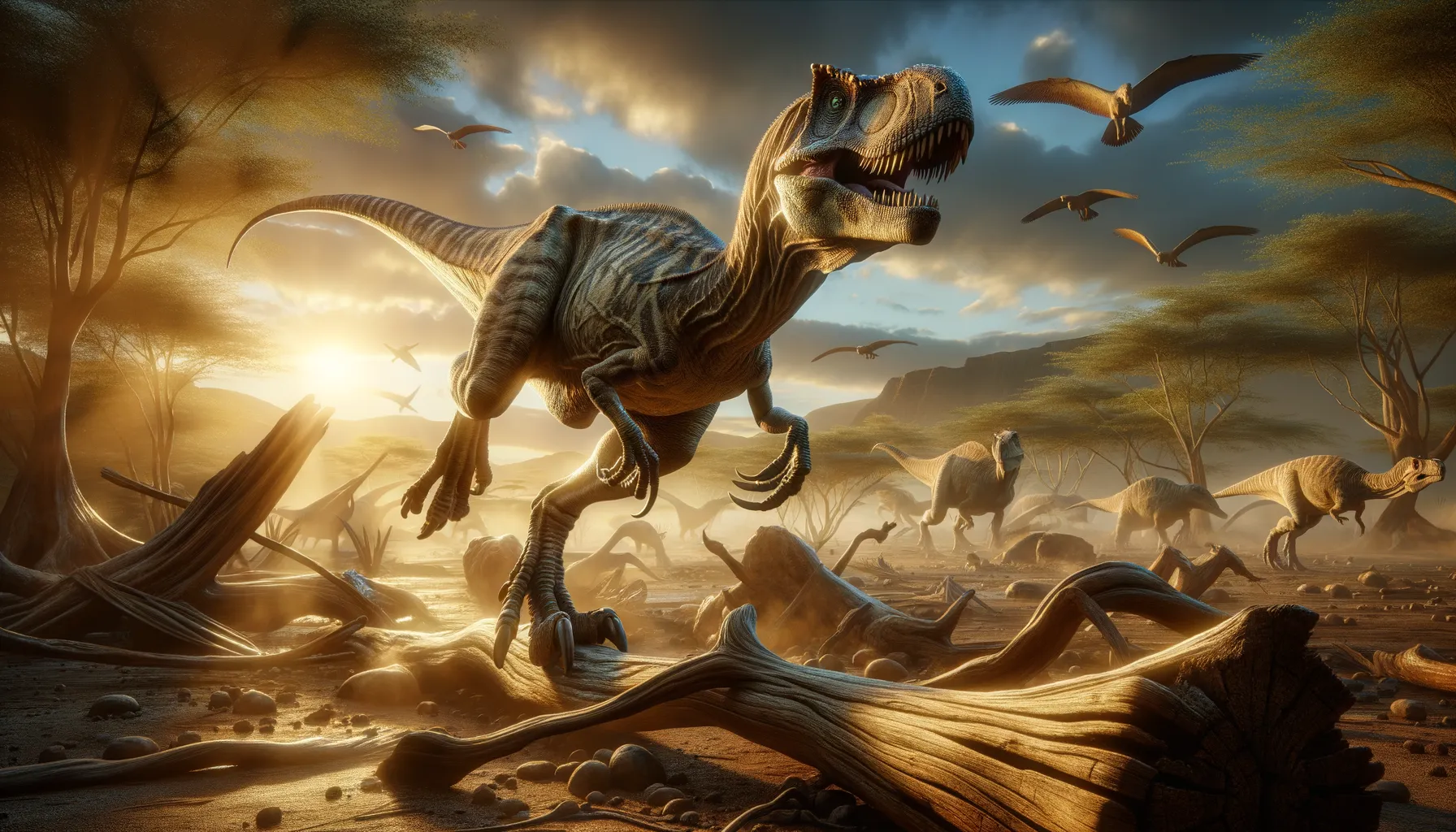
Fosterovenator
Swift predator of the prehistoric plains.
Period
Cretaceous
Length
Measured up to 6 meters long.
Height
Around 2 meters tall at the hips.
Weight
Approximately 200 to 250 kilograms.
Fosterovenator was a nimble predator from the Cretaceous period. Known for its agility, it had a keen sense of sight and smell. Its body was built for speed and efficiency, allowing it to thrive in various environments. With powerful legs and sharp claws, it was an adept hunter. Fossils of this dinosaur provide crucial insights into the predatory behaviors of the time, revealing much about the ecosystem of ancient Earth.
Diet
Fosterovenator was a carnivore that primarily hunted smaller dinosaurs and prehistoric mammals. It used its speed to chase down prey and had sharp teeth to effectively process its meals. Its diet consisted mainly of meat, making it a top predator in its ecosystem.
Hunting
Fosterovenator relied on its speed and cunning to hunt. It used its keen senses to track down prey and preferred to stalk its targets before a sudden burst of speed resulted in a surprise attack. It often hunted alone, but sometimes worked in small groups to take down larger prey.
Environmental challenges
Fosterovenator faced competition from other predators in its habitat, requiring it to be strategic in its hunting practices. Changes in climate during the Cretaceous period also posed challenges, affecting the availability of prey. Natural disasters, like volcanic eruptions, might have temporarily displaced its hunting grounds, forcing it to adapt to new environments. These factors often led to periods of scarcity, testing its endurance and survival skills.
Speed
Fast runner, capable of quick sprints.
Lifespan
Estimated around 20 to 30 years.
First discovery
Uncovered in the early 21st century.
Fun Facts
- Fosterovenator is a theropod dinosaur, meaning it was a bipedal carnivore walking on two legs.
- The name 'Fosterovenator' honors John Foster, a paleontologist known for his work on Jurassic dinosaurs.
- 'Ovenator' translates to 'hunter' in Latin, reflecting its predatory nature.
- Fosterovenator lived during the Jurassic period, around 150 million years ago.
- Fossils of Fosterovenator have been found in the Morrison Formation, a famous Late Jurassic fossil site in the U.S.
- Despite its fearsome name, Fosterovenator was a relatively small dinosaur compared to giants like T. rex.
- It is an important discovery for understanding the diversity of predatory dinosaurs during the Jurassic era.
Growth and Development
Young Fosterovenator dinosaurs grew rapidly, reaching a formidable size within a few years. They went through several stages of development, shedding skin and growing stronger limbs as they matured. Learning to hunt from an early age, juveniles practiced stalking and capturing smaller creatures. Their ability to adapt to various environments was key to their growth, aiding in the continued evolution of their species.
Habitat
Fosterovenator lived in diverse environments ranging from forests to open plains, allowing it to hunt a variety of prey. Its habitat changed with the shifting climate and geological activity of the Cretaceous period. It was well-suited to adapt to different terrains, often moving between areas in search of food. The abundance of prey in certain regions made those areas prime habitats for this agile hunter.
Interaction with other species
Fosterovenator interacted primarily with other carnivorous dinosaurs as competitors. It occasionally crossed paths with herbivorous dinosaurs, which sometimes became prey. The dinosaur established territories through vocalizations and displays, often engaging in confrontations with rivals. Mutual respect was maintained amongst similar-sized predators to avoid unnecessary conflict.
Natural lifespan
Its natural lifespan was around 25 years under favorable conditions.
Reproduction
Fosterovenator reproduced by laying eggs, with nests typically built in secluded areas. They exhibited some parental care, guarding their eggs against potential threats. After hatching, young dinosaurs were somewhat independent, quickly learning to fend for themselves. The species likely had a breeding season, ensuring offspring emerged during optimal conditions for survival.
Social behaviour
Fosterovenator was primarily solitary but occasionally formed small packs for hunting purposes. Social interactions were limited outside of mating seasons and hunting collaborations. It communicated through a series of roars and postures, establishing dominance and territorial boundaries. Young dinosaurs often learned social behavior from observing older members of the species.
Fossil locations
Fossils of Fosterovenator have been found in various parts of North and South America. These sites have provided comprehensive insights into its physical structure and diet. The discovery of fossils in different geographical regions suggests a wide range of habitable environments. These findings have been instrumental in understanding the ecological dynamics during the Cretaceous period.
